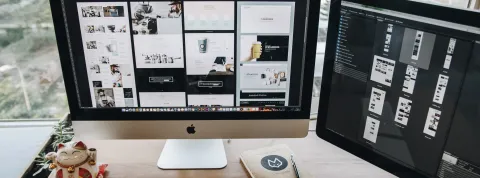
What’s the difference between UI and UX design?
In the world of website and application design, two terms are often used: UX design and UI design. These two concepts are often confused, but they are not interchangeable. Although both concepts are essential to the design of a successful project, UX design and UI design focus on different aspects of the user experience. Let’s take a look at the main differences between them, and how they can complement each other to make browsing easier for web users. Are you passionate about digital professions? Discover our Digital Marketing Master’s program to learn how to design an effective, user-centered digital marketing strategy.
What is UX and UI Design?
UX design, or "User Experience Design", is a user-centered design process that aims to improve satisfaction and loyalty by making a digital product, such as a website or application, accessible, usable and user-friendly. Its aim is to create a pleasant, intuitive experience, where every interaction with the interface perfectly meets user expectations.
The UX designer's role is to identify users' needs, motivations and behaviors in order to design a fluid and coherent navigation path. This process begins with an in-depth research phase, in which designers analyze user preferences through surveys, interviews, the definition of personas and tools such as empathy maps and usability tests. This information is used to lay the foundations for a tailored experience.
Once requirements have been identified, UX designers structure the interface using key techniques:
Information architecture: logical organization of content and functions to facilitate navigation.
Information hierarchy: clear, orderly presentation to help users find what they're looking for quickly.
Navigation and interaction: design menus, buttons and hyperlinks to deliver a smooth, intuitive experience.
UX design is characterized by its iterative approach, where prototypes are continuously tested and optimized. The ultimate goal is to ensure that every interaction with the interface is simple, clear and pleasant, thus reinforcing user satisfaction and loyalty.
UI design, or "User Interface Design", focuses on the visual aspect and the user's interaction with an interface. It encompasses elements such as colors, typography, icons, buttons and the general layout of the page. Unlike UX design, which focuses on the overall experience, UI design represents the visible, tangible part of a digital product.
Good UI design isn't just about aesthetics: it's about creating a user interface that's intuitive, attractive and easy to use. To achieve this, UI designers work closely with UX designers to ensure consistency between visual appearance and overall experience.
The main components of UI design include :
Typography: The choice of fonts, sizes and spacing is essential to establish a clear hierarchy of information and guide the user through the interface.
Colors: Used to reinforce a brand's visual identity, improve legibility and arouse emotions, colors play a key role in the visual experience.
Icons and graphics: These simple, recognizable visual elements help to communicate information quickly and make navigation easier.
Layout: The layout of elements must be coherent and intuitive, with adaptability to different device types and screen sizes to ensure a fluid experience.
In short, UI design harmoniously combines aesthetics and functionality to offer an interface that appeals to the user while meeting his or her needs.
What is the difference between UI and UX?
UX design and UI design are two closely related but distinct design disciplines in the world of digital design. UX design is concerned with the way a user navigates a site or application, while UI design focuses in some way on the pleasure the user experiences.
UX design is often considered more strategic than UI design, as it requires an in-depth understanding of both the users and the business objectives of the digital product. UX designers work to create a consistent and satisfying user experience, using methods such as usability testing and user research to validate their designs.
UI design, on the other hand, is considered more tactical, focusing on user interface details such as color, typography and layout. UI designers work to create visually appealing and easily usable user interfaces.
We can use the analogy of a house to explain the fundamental differences between UX and UI design. The foundations (UX) come first: they establish the floor plan, the location of each room and door, and the construction of a staircase if necessary. We can then take care of the layout and decoration of the house (UI), choosing the color of the wallpaper, the appropriate furniture, the carpets and even the photos we want to hang on the walls.
The need to integrate user experience into digital strategy
In today's digital world, companies need to focus on the user experience to stay competitive. Integrating UX design into a digital strategy can help a company achieve its business objectives more effectively.
First and foremost, UX design enables us to better understand our users. By analyzing their needs and behaviors, a company can design digital products that meet their expectations to increase engagement and loyalty.
UX design can also help reduce costs. By designing digital products that meet users' needs from the outset, companies avoid having to make costly modifications after launch. What's more, digital products that offer a consistent and satisfying user experience are more likely to be adopted by users, which can reduce marketing and customer acquisition costs.
Finally, UX design can help a company differentiate itself from the competition. In a constantly evolving market, it is essential to offer digital products that provide a superior user experience to those offered by rivals, in order to position oneself as a leader.
Would you like to learn how to build innovative digital marketing strategies? Take our Digital Marketing Master's course and become an expert in data, customer relations and innovation.
Would you like to learn how to build innovative digital marketing strategies? Follow our Master Marketing Digital and become an expert in data, customer relations and innovation.